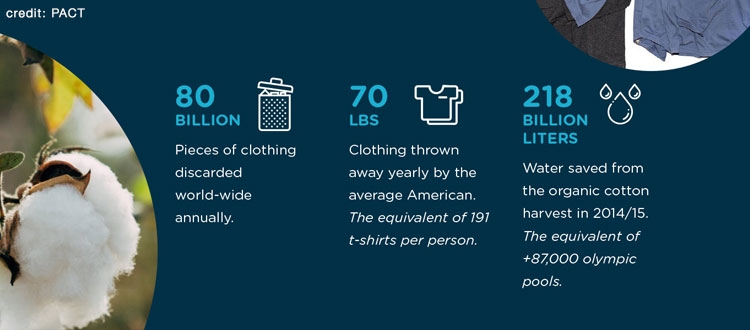How Our Clothing Choices Impact Our Environment and Physical Health
Women make up half of the world. The choices we make as consumers carry an enormous impact. The more we educate ourselves and make those choices consciously — and the more vocal we are about the effects of our choices on a global scale— the more we can ignite positive change.
Zooming in On The Clothing Industry
A substantial portion of our consumer choices occur within the fashion industry. The womenswear industry alone is valued at $621 billion dollars, which is $219 billion more than menswear. Fashion is and has historically been a significant piece of our individual identities.
However, what many of us may not realize, is that each time we make a clothing purchase, we are potentially supporting practices with grave consequences for our environment and our health.
The Environment
For starters, the only industry causing more pollution than Big Textile is the oil industry. Fashion involves supply chains of production, raw material, textile manufacture, clothing construction, shipping, retail, use and disposal.
Taking a closer look at this sequence of events, we find somewhat obvious pollutants, such as the pesticides used in farming cotton, toxic dyes used in manufacturing, the amount of waste clothing produces, along with the harmful amount of natural resources used in extraction, farming, harvesting, processing, manufacturing, and shipping.
For example, the manufacture of synthetic fibers like polyester uses exorbitant amounts of energy and crude oil, which release harmful emissions like volatile organic compounds, particulate matter, and acid gases like hydrogen chloride. Polyester and nylon are both made from petrochemicals, meaning they are inherently unsustainable. Nylon manufacture emits large amounts of the greenhouse gas nitrous oxide. Just one pound of nitrous oxide has a 300x larger impact than carbon dioxide on global warming.
Equally alarming is the amount of waste generated by the fashion industry. In 2013 alone, 15.1 million tons of textile waste was generated.
Your Health
While few studies have been conducted to directly link chemicals in clothing to human health issues, the chemicals often found in garments (or used in their production) have been linked to neurotoxicity, liver, kidney and lung disorders, cancer and more. For example, clothes that are marketed as wrinkle-resistant are often made with formaldehyde and have been linked with eye and nose irritation, and allergic reactions on people’s skin.
There are thousands of potentially hazardous chemicals used when making clothes, including:
- Dimethylformamide found in acrylic fabrics
- Azo dyes used to color clothes
- Phthalates found in plastic raincoats, fake leather and waterproof clothing
- Nanosilver used in clothes marketed as antimicrobial
Again, chemicals in clothing have not yet been determined to cause human health concerns more serious than allergic reactions and irritations, but the fact of the matter is that there are safer alternatives, and using these chemicals isn’t necessary.
The Fast Fashion Problem
In the modern world, consumerism has become increasingly accessible and rampant. One dire example of this kind of wasteful consumerism is what’s known as fast fashion, a 10-year-old trend where clothing is essentially designed to be more disposable.
Accelerating Consequences
Americans dispose of more than 68 pounds of clothes per person annually, and fast fashion only ignites this harmful chain reaction of churn and burn, leading to an acceleration of the textile industry’s environmental consequences.
The EPA has declared a number of textile manufacturing facilities to be hazardous waste generators, and clothing and other textiles represent approximately 9% of municipal solid waste. The amount of discarded clothing tossed into landfills is projected to reach 35.4 billion pounds in 2019. The fashion industry’s CO2 emissions are also projected to increase by more than 60% to nearly 2.8 billion tons per year by 2030.
A Disaster For Women
Perhaps even more concerning than fast fashion’s carbon footprint is the poor labor practices it supports. To quote a jarring Forbes headline, “fast fashion is a disaster for women and the environment.”
80% of the 75 million people who make our clothes today are made up of women ages 18-24 years old, and it takes them 18 months “to earn what a fashion brand CEO makes on their lunch break.” Most make less than $3 a day.
Cheap clothes are made by underage workers entering the industry as young as 14 to work long hard hours (an avg. 14 hrs per day in sweatshops) for low wages, while dealing with sexual harassment.
— Forbes
Sustainable Solutions
By buying better, we have the power to inspire change. Sustainable, healthy, and ethical options exist. To address the negative impact of fast fashion at its source, many manufacturers have been working to develop eco-fashion. The International Standards Organization (ISO) defines eco-fashion as “identifying the general environmental performance of a product within a product group based on its whole life-cycle in order to contribute to improvements in key environmental measures and to support sustainable consumption patterns.”
Better Fabrics
One approach the industry has taken is using sustainably grown crops, including cotton, hemp, bamboo, and others that require less pesticides, irrigation, and other resources. Sustainable fabrics include:
- Organic cotton
- Silk
- Organic wool
- Hemp
- Alpaca
- Angora
- Camel
- Cashmere
- Mohair
- Flax
- Ramie
- Aluyot
Perhaps most popular is the growth and use of organic cotton, which significantly reduces excess pollution and the dependence on water, pesticides, and fertilizers, lessens farmer exposure to chemicals, and is being used by clothing brands doing great things in the way of cutting costs for consumers without cutting quality or sacrificing ethics.
What You Can Do
The mainstream fashion industry is causing major problems for our environment and our health. But we can create real change, not only by being conscience buyers and recyclers, but also by taking the time to educate others on better practices. A few ways to make a difference:
Buy from the right companies. Keep an eye out for certifications like GOTS, or Global Organic Textile Standards. This certification is a leading textile processing standard for organic fibers, and includes strict ecological and social criteria to ensure workers involved at all levels of the supply chain are paid living wages and working in good conditions. Making the switch to sustainable materials and environmentally-friendly means production, clothing manufacturers like PACT Apparel, Patagonia, and KNOWN SUPPLY are just a few worth researching.
Check out your local consignment and thrift shops. If just 12-15% of Americans shopped at consignment and resale stores, roughly 2.5 billion pounds of textile waste would be saved from being dumped into landfills.
Opt out of fast fashion by choosing quality items that are made to last, rather than those meant to last one season.
Find a local organization that is recycling clothing, host a swap with your friends, or find a way to re-use old clothes. The amount of waste caused by discarded clothing is disconcerting and on the rise. The textile industry has one of the poorest recycling rates of any reusable material. In the U.S., people only donate roughly 15% of their discarded clothes each year.
Share this information with your friends!
————————————–
Written By: M. Stirpe
About PACT:
PACT is an organic, Fair Trade cotton clothing company whose clothes are certified GOTS, or Global Organic Textile Standard. They proudly employ women at every level of their manufacturing process and pay them a living wage. Their goal is to ‘create the comfiest clothing in the world without destroying the earth, or harming people.’






Thanks for raising this issue! “Safe” non-toxic clothing shouldn’t be as hard to find as it is now. Even organic cotton or other fibers can be processed in toxic ways, so unless the life cycle is certified to be non-toxic, you could still end up with toxic underwear made from organic cotton.
Re health effects, I and numerous others have discovered that our fibro flares are caused by chemicals and residues in clothing (or even some furnishings).
Chronic pain is a huge problem in our society now. For some people (who really knows how many) it’s due to the toxic chemicals in textiles and laundry products (and other things too, but this postis about clothing and textiles).
There’s a big push to get people to buy used clothing, because some of the chemicals have been washed out (and down the drain into … our drinking water?), but many laundry products are also toxic in and of themselves and difficult if not impossible to remove (some people wash countless times, using a lot of product, water, and energy – both personal and electric) to attempt to remove the chemicals and fragrances, many have no luck at all.
These issues need to be addressed at the source… our air, water, and health depend on it!
p.s.
If anyone knows of some affordable organic linen clothing, (processing too – no ‘low impact’ dyes, and from fragrance-free suppliers) please let me know!
Excellent article. The quality and materials of clothing can adversely affect human health. Incorrectly chosen size of clothes can cause strong discomfort by walking (especially if it’s shoes). In addition, modern clothes are produced in China, Taiwan, etc. What materials, dyes are used in manufacturing? Is technology observed? Because of this, many people may have an allergic reaction. Also, a designated list of materials may not be correct. Therefore, if you have allergy to any dyes or materials (which are used to make clothes), then it is better to buy eco clothing. In the production of such clothes, only eco fibers are used.
Second hand stores are notorious for liberally spraying the clothes with even more chemicals to cover body odors.
Putting dryer sheets in with clothes you are mailing to some unsuspecting person who wants to wear them ruins them in many instances.
If we stop buying poor quality, it will push brands to improve the quality of their garments. It will also allow us to keep our clothes longer, which is good for our wallets and for the environment.